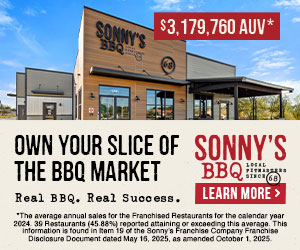Cold Stone Exec Leading Charge Into Asia Markets
(Monday, January 01, 2007) - Cold Stone Creamery executives recently began Year 2 of their foray into selling ice cream overseas with the goal of growing the brand in markets such as Mexico, Canada and South America.
So far per store sales at its 12 international stores in the Pacific Rim are running at about $1 million annually, about three times higher than at U.S. stores.
In December, the ice-cream franchise company elevated Lee Knowlton to president of international and new business development. Knowlton was part of the executive team that introduced Cold Stone's signature super-rich ice cream, which can be personalized with candy, fruit and nuts, and the company's singing-and-dancing style of serving it to Japan in 2005 and Korea in 2006.
He reports directly to CEO and Chairman Doug Ducey, although Jim Flaum remains president and chief operating officer.
When Knowlton sat down with The Republic, Cold Stone was near signing a deal with a partner to bring Cold Stone to Saudi Arabia and the United Arab Emirates. The deal is expected to be signed this week.
In the company's Scottsdale office, Knowlton's crew was helping managers from China and Taiwan learn to make shakes, create cakes and serve up made-to-order ice cream so they can open stores in April.
Kuo-Hui "Eric" Hsieh and Hsiao "Ann" Ching Yeh, part of Cold Stone's China and Taiwan team, couldn't wait to get involved in bringing the ice cream overseas.
"We loved the concept - the happy and fun for customers," Hsieh said.
Said Hsiao, through her interpreter: "It's like a show a person can watch, that's why it's good" business.
Knowlton said so far, the international experience has been a hit. Some other questions and answers:
Question: It's been about a year since Cold Stone went to Japan. Are you starting to get a picture of same-store sales and whether the concept is a success?
Answer: We opened eight stores this year, so we have nine now up and running and the first one in Roppongi Hills (shopping center in Tokyo) did cross over (the year mark) Nov. 1. We've had tremendous success . . . (but) we've basically been flat the last year, which to me is incredibly positive because our sales have been so high. If anything, I had been expecting there to be a drop (as the novelty fades). . . .
(Sale are trending) well north of a $1 million a year. . . . In the U.S., we're about $400,000 (average store sales).
Q: What has made it such a hit?
A: Two things they said: The ice cream tastes great and I feel so great when I'm in the store. And in Asia, feeling is so important. . . .
When you walk into a typical ice cream parlor in Asia, . . . it's a basic transaction.
(He explains how much more animated the Cold Stone experience is, which includes singing after a donation is made to a charity. Tipping isn't allowed.)
They think this (entertainment) is incredible.
Q: Has it become a (consumer) destination?
A: Absolutely. The word of mouth has been incredible.
Q: The stores look crowded with workers.
A: We have an average of 15 on a shift. (In the U.S., stores have two to three workers on a weeknight shifts and five to seven on weekend nights).
Q: Are the sizes smaller there?
A: Yes, there is really an emphasis of you need to eat what you order.
Q: What about pricing?
A: It's very similar. . . . If you go there, you wouldn't notice the price change.
Q: What is the outlook five years from now?
A: We're looking at 20 to 25 (stores) a year for the next three to five years. It's very controlled growth.
Q: What did you find to be the biggest challenge going to Japan?
A: From an operational perspective, opening the first store is never easy. There's literally a thousand details. . . . But the most challenging is just in the beginning, sourcing everything, the right site, hiring the people, the training, opening up and educating on what it is. ... Once the store opened, fortunately we had done pretty well and could build from that.
Q: Any surprises?
A: A lot of blogs started before we opened . . . they had been to Cold Stone in Hawaii, . . . California, New York. We had some decent brand awareness before we opened the store.
Q: Korea opened in July.
A: Yes, with three stores. . . . We'll end the year with four. Our goal is to open 12 to 15 more next year.
Q: How is that working out? Same as Japan?
A: It's not at the Japan level, but exceeding our U.S. sales and close to $1 million (in average annual sales volume). . . .
Q: Tell me more about the China/Taiwan deal.
A: Our goal is to open the first store in Taipei in April. There's a famous building called the 101 building, it's the tallest building in Asia, and we'll open around the base from that. Then Shanghai at the end of April. . . . Beijing, we're shooting for August. There will be three to five stores in each of these areas next year.
Then in '08, we'll go at a 10 to 15 clip in those markets.
Q: Who's your typical customer?
A: It's female, middle income, 18 to 34 years old.
Q: What's next?
A: Asia is still our main focus. . . . We have a letter of intent in Indonesia, Malaysia and Singapore. . . . And we're continuing to look at Mexico, Canada, England and some next markets. Our goal is to be operating in at least eight countries and have about 100 stores by the end of the year in those eight countries.
(Also,) South America excites me, Brazil, Argentina. You've got great summer weather and some Western brands down there enjoying some success. (But) we've been strategic in our growth. We took the world and tried to rank it with 15 to 20 metrics.
###
| ADVERTISE | SPONSORED CONTENT |
Franchise News
By Type
- Expansions & Growth
- Financial & Earnings Claims
- Mergers & Acquisitions
- Personnel Changes
- Conferences & Events
- Product Announcements
- Media Coverage
- Strategic Alliances
By Sector
| ADVERTISE | SPONSORED CONTENT |



 The franchise opportunities listed above are not related to or endorsed by Franchising.com or Franchise Update Media Group. We are not engaged in, supporting, or endorsing any specific franchise, business opportunity, company or individual. No statement in this site is to be construed as a recommendation. We encourage prospective franchise buyers to perform extensive due diligence when considering a franchise opportunity.
The franchise opportunities listed above are not related to or endorsed by Franchising.com or Franchise Update Media Group. We are not engaged in, supporting, or endorsing any specific franchise, business opportunity, company or individual. No statement in this site is to be construed as a recommendation. We encourage prospective franchise buyers to perform extensive due diligence when considering a franchise opportunity.